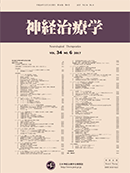Volume 33, Issue 2
Displaying 1-50 of 73 articles from this issue
-
2016 Volume 33 Issue 2 Pages 67-70
Published: 2016
Released on J-STAGE: August 10, 2016
Download PDF (339K) -
2016 Volume 33 Issue 2 Pages 71-73
Published: 2016
Released on J-STAGE: August 10, 2016
Download PDF (451K)
-
2016 Volume 33 Issue 2 Pages 75-82
Published: 2016
Released on J-STAGE: August 10, 2016
Download PDF (598K)
-
2016 Volume 33 Issue 2 Pages 83-87
Published: 2016
Released on J-STAGE: August 10, 2016
Download PDF (920K)
-
2016 Volume 33 Issue 2 Pages 88-90
Published: 2016
Released on J-STAGE: August 10, 2016
Download PDF (392K)
-
2016 Volume 33 Issue 2 Pages 91
Published: 2016
Released on J-STAGE: August 10, 2016
Download PDF (201K) -
2016 Volume 33 Issue 2 Pages 92
Published: 2016
Released on J-STAGE: August 10, 2016
Download PDF (189K)
-
2016 Volume 33 Issue 2 Pages 93
Published: 2016
Released on J-STAGE: August 10, 2016
Download PDF (179K) -
2016 Volume 33 Issue 2 Pages 94-98
Published: 2016
Released on J-STAGE: August 10, 2016
Download PDF (454K) -
2016 Volume 33 Issue 2 Pages 99
Published: 2016
Released on J-STAGE: August 10, 2016
Download PDF (175K) -
2016 Volume 33 Issue 2 Pages 100-104
Published: 2016
Released on J-STAGE: August 10, 2016
Download PDF (1365K) -
2016 Volume 33 Issue 2 Pages 105-108
Published: 2016
Released on J-STAGE: August 10, 2016
Download PDF (591K) -
2016 Volume 33 Issue 2 Pages 109
Published: 2016
Released on J-STAGE: August 10, 2016
Download PDF (203K)
-
2016 Volume 33 Issue 2 Pages 110-114
Published: 2016
Released on J-STAGE: August 10, 2016
Download PDF (1006K) -
2016 Volume 33 Issue 2 Pages 115-121
Published: 2016
Released on J-STAGE: August 10, 2016
Download PDF (3133K) -
2016 Volume 33 Issue 2 Pages 122
Published: 2016
Released on J-STAGE: August 10, 2016
Download PDF (197K) -
2016 Volume 33 Issue 2 Pages 123
Published: 2016
Released on J-STAGE: August 10, 2016
Download PDF (214K) -
2016 Volume 33 Issue 2 Pages 124
Published: 2016
Released on J-STAGE: August 10, 2016
Download PDF (195K) -
2016 Volume 33 Issue 2 Pages 125-130
Published: 2016
Released on J-STAGE: August 10, 2016
Download PDF (2526K) -
2016 Volume 33 Issue 2 Pages 131-133
Published: 2016
Released on J-STAGE: August 10, 2016
Download PDF (349K) -
2016 Volume 33 Issue 2 Pages 134
Published: 2016
Released on J-STAGE: August 10, 2016
Download PDF (136K) -
2016 Volume 33 Issue 2 Pages 135-140
Published: 2016
Released on J-STAGE: August 10, 2016
Download PDF (1465K) -
2016 Volume 33 Issue 2 Pages 141
Published: 2016
Released on J-STAGE: August 10, 2016
Download PDF (186K) -
2016 Volume 33 Issue 2 Pages 142
Published: 2016
Released on J-STAGE: August 10, 2016
Download PDF (199K)
-
2016 Volume 33 Issue 2 Pages 143
Published: 2016
Released on J-STAGE: August 10, 2016
Download PDF (212K) -
2016 Volume 33 Issue 2 Pages 144
Published: 2016
Released on J-STAGE: August 10, 2016
Download PDF (208K) -
2016 Volume 33 Issue 2 Pages 145-149
Published: 2016
Released on J-STAGE: August 10, 2016
Download PDF (448K) -
2016 Volume 33 Issue 2 Pages 150-154
Published: 2016
Released on J-STAGE: August 10, 2016
Download PDF (2833K) -
2016 Volume 33 Issue 2 Pages 155-157
Published: 2016
Released on J-STAGE: August 10, 2016
Download PDF (956K) -
2016 Volume 33 Issue 2 Pages 158-161
Published: 2016
Released on J-STAGE: August 10, 2016
Download PDF (813K)
-
2016 Volume 33 Issue 2 Pages 162
Published: 2016
Released on J-STAGE: August 10, 2016
Download PDF (212K) -
2016 Volume 33 Issue 2 Pages 163-166
Published: 2016
Released on J-STAGE: August 10, 2016
Download PDF (433K) -
2016 Volume 33 Issue 2 Pages 167
Published: 2016
Released on J-STAGE: August 10, 2016
Download PDF (197K) -
2016 Volume 33 Issue 2 Pages 168-171
Published: 2016
Released on J-STAGE: August 10, 2016
Download PDF (366K) -
2016 Volume 33 Issue 2 Pages 172-175
Published: 2016
Released on J-STAGE: August 10, 2016
Download PDF (638K)
-
2016 Volume 33 Issue 2 Pages 176
Published: 2016
Released on J-STAGE: August 10, 2016
Download PDF (189K) -
2016 Volume 33 Issue 2 Pages 177-181
Published: 2016
Released on J-STAGE: August 10, 2016
Download PDF (1094K) -
2016 Volume 33 Issue 2 Pages 182
Published: 2016
Released on J-STAGE: August 10, 2016
Download PDF (178K) -
2016 Volume 33 Issue 2 Pages 183
Published: 2016
Released on J-STAGE: August 10, 2016
Download PDF (168K)
-
2016 Volume 33 Issue 2 Pages 184
Published: 2016
Released on J-STAGE: August 10, 2016
Download PDF (234K) -
2016 Volume 33 Issue 2 Pages 185
Published: 2016
Released on J-STAGE: August 10, 2016
Download PDF (237K) -
2016 Volume 33 Issue 2 Pages 186-190
Published: 2016
Released on J-STAGE: August 10, 2016
Download PDF (1563K) -
2016 Volume 33 Issue 2 Pages 191
Published: 2016
Released on J-STAGE: August 10, 2016
Download PDF (185K) -
2016 Volume 33 Issue 2 Pages 192-193
Published: 2016
Released on J-STAGE: August 10, 2016
Download PDF (282K)
-
2016 Volume 33 Issue 2 Pages 194-198
Published: 2016
Released on J-STAGE: August 10, 2016
Download PDF (2316K) -
2016 Volume 33 Issue 2 Pages 199
Published: 2016
Released on J-STAGE: August 10, 2016
Download PDF (222K) -
2016 Volume 33 Issue 2 Pages 200-204
Published: 2016
Released on J-STAGE: August 10, 2016
Download PDF (1863K)
-
2016 Volume 33 Issue 2 Pages 205
Published: 2016
Released on J-STAGE: August 10, 2016
Download PDF (246K) -
2016 Volume 33 Issue 2 Pages 206-209
Published: 2016
Released on J-STAGE: August 10, 2016
Download PDF (1149K) -
2016 Volume 33 Issue 2 Pages 210-214
Published: 2016
Released on J-STAGE: August 10, 2016
Download PDF (2021K)
